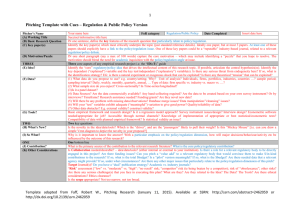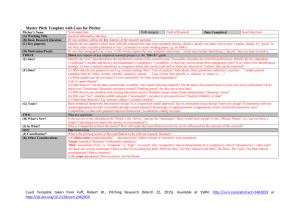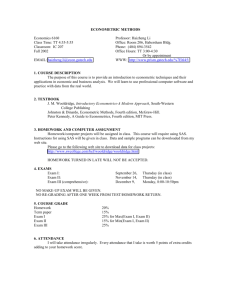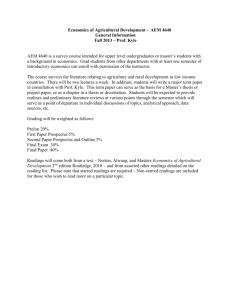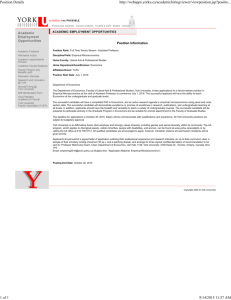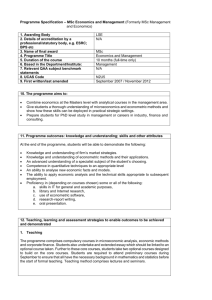FNCE 926 EMPIRICAL METHODS IN CORPORATE FINANCE
advertisement
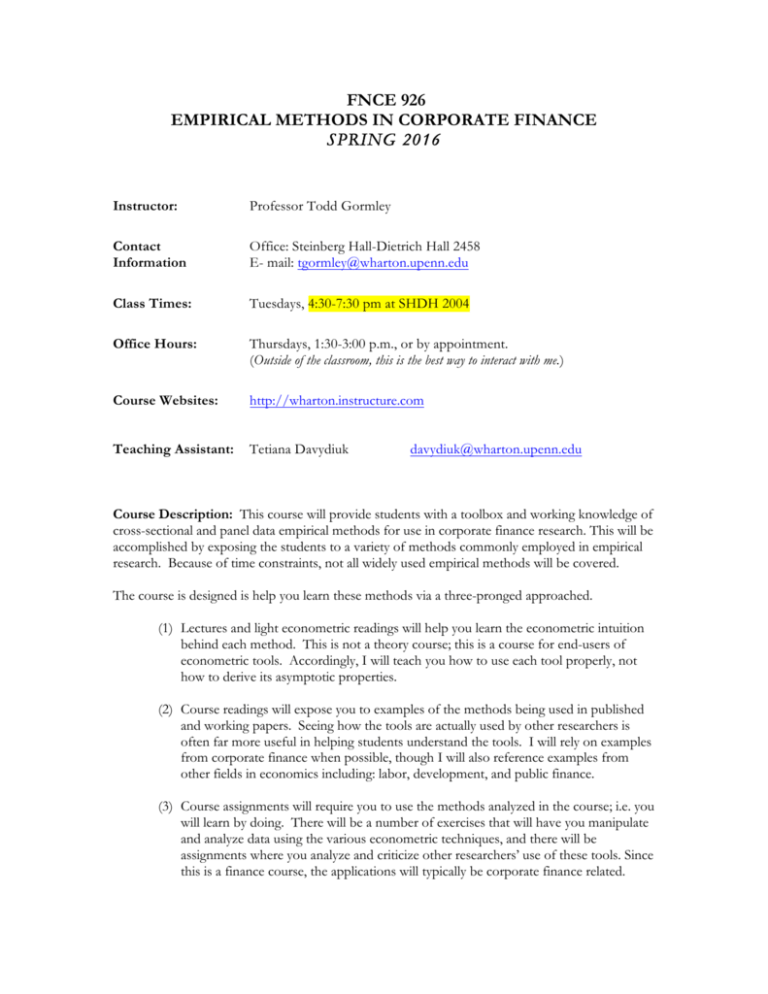
FNCE 926 EMPIRICAL METHODS IN CORPORATE FINANCE SPRING 2016 Instructor: Professor Todd Gormley Contact Information Office: Steinberg Hall-Dietrich Hall 2458 E- mail: tgormley@wharton.upenn.edu Class Times: Tuesdays, 4:30-7:30 pm at SHDH 2004 Office Hours: Thursdays, 1:30-3:00 p.m., or by appointment. (Outside of the classroom, this is the best way to interact with me.) Course Websites: http://wharton.instructure.com Teaching Assistant: Tetiana Davydiuk davydiuk@wharton.upenn.edu Course Description: This course will provide students with a toolbox and working knowledge of cross-sectional and panel data empirical methods for use in corporate finance research. This will be accomplished by exposing the students to a variety of methods commonly employed in empirical research. Because of time constraints, not all widely used empirical methods will be covered. The course is designed is help you learn these methods via a three-pronged approached. (1) Lectures and light econometric readings will help you learn the econometric intuition behind each method. This is not a theory course; this is a course for end-users of econometric tools. Accordingly, I will teach you how to use each tool properly, not how to derive its asymptotic properties. (2) Course readings will expose you to examples of the methods being used in published and working papers. Seeing how the tools are actually used by other researchers is often far more useful in helping students understand the tools. I will rely on examples from corporate finance when possible, though I will also reference examples from other fields in economics including: labor, development, and public finance. (3) Course assignments will require you to use the methods analyzed in the course; i.e. you will learn by doing. There will be a number of exercises that will have you manipulate and analyze data using the various econometric techniques, and there will be assignments where you analyze and criticize other researchers’ use of these tools. Since this is a finance course, the applications will typically be corporate finance related. Reading Materials: I will teach from slides, which I will make available to you before each class on the course website, Canvas. I will be drawing from a variety of sources including various textbooks, journal articles, working papers, and other professors’ lecture notes. As such, there is no required “textbook,” but I will make note of the appropriate references for each lecture. The relevant methodology readings for each lecture are provided at the bottom of this syllabus, and students are expected to read these prior to the lecture. Additionally, most lectures will contain student presentations of three papers related to the previous week’s lecture topic. A list of papers to be presented is given below. Prerequisites: You should have taken a graduate sequence in econometrics. Practically speaking, you should be comfortable with econometrics at the level of William Greene’s Econometric Analysis and Jeffrey Wooldridge’s Econometric Analysis of Cross-Section and Panel Data. Coursework: There will be three graded components to the course. These are designed to help you learn the econometric tools used in the literature while also preparing you for a successful career in academic research. The three assignments are as follows: 1. Empirical exercises You will be asked to download data and write code to implement some of the tools taught in the course. The five exercises are designed to teach you how to actually use these tools. It’s one thing to learn about a difference-in-differencein-difference estimation and another thing to actually estimate one. The assignments will be completed in Stata, and to receive credit for the assignment, you will e-mail me your DO file, which I will run on a dataset to check whether your programming and regressions are correct. 2. In-class presentations/discussions For most classes, there will be three papers assigned that students (regardless of whether you are just auditing) must read and present a discussion of in-class. Students will form groups of their own choosing, and we will assign each group their paper in the week ahead. E.g. If I give a lecture on instrumental variable estimations, then at the end of the lecture, I will assign three papers that make use of IV strategies. Students will present their discussions of these three papers in the second half of the next class. Each group will need to make a 10 minute presentation that discusses the paper, and each presentation will be followed by in-class discussion. The purpose of the assignment is twofold: (1) Presentations are one key way people in academia will come to know (and assess) you. So, it’s a good idea to get some practice now. And (2), this will help you apply and think critically about the empirical tools discussed in the previous lecture. Because students find it helpful to study for the final exam, I will also post each presentation on Canvas after class is finished. To ensure participation following each presentation, each student must also type up one concern they had about each of the two papers their group did NOT present and hand these in at the start of class. I will randomly select 1 submission for each assigned paper and have that randomly selected student 2 elaborate upon their comment in class. The comments should be very short [2-3 sentences maximum] and designed to do one of two things: (1) isolate what you thought the biggest problem of the paper was, or (2) identify a concern you think the presenting group might overlook. Every failure to turn in this sheet of comments will result in a 2-point reduction in participation points. 3. Write a research proposal Basically, you will be asked to sketch out an outline for a possible empirical paper you could write using tools taught in the course. You’ll need to come up with an interesting question, place your question in the relevant literature, sketch out an identification strategy for answering that question, and identify the necessary datasets to implement your identification strategy. If you want, you can think of this as a possible start to your eventual second year paper. Presentation Groups: The class will be organized into three presentation groups, which will each give a presentation during lectures that include student presentations of related research papers. You are free to choose your own members. I just recommend that you split yourselves into three roughly equal-sized groups. We will choose our groups in the very first lecture, but students are free to change groups later on if needed. Limitations: Time limitations impose certain restrictions on what we can accomplish in this course. For example, we will not cover all of the methods you might need or should know. We also will not cover each method in excruciating detail. Arguably, you could build an entire course (research agenda) around each method. Canvas: Important course materials, such as lecture notes, required assignments, and other useful information will be available on the course web page at Canvas: http://wharton.instructure.com. You will also use this website to turn in all of your exercises & research proposals. Questions: Please, just ask. I don’t anticipate that everything I say in class or my lecture notes will be crystal clear. So, if something is confusing, please just ask me. I can’t guarantee to always have an immediate answer, especially for questions of a more technical nature, but I promise to always find one and get back to you. Participation: You will be graded on participation. Basically, I expect each student to give inclass presentations during the semester and to turn in weekly comments on each paper their group was not assigned to present. (You will be working in groups to write the presentation, but ultimately, only one of you gets up to give the presentation each week.) You should consider yourself likely to get “full participation credit” if you split the presentations equally among group members and turn in your weekly comments on each paper. But, failure to do presentations or to turn in weekly comments on the assigned readings will result in a lower grade. Final Exam: There will be a final exam in the last class period. 3 Grading: You should not be too worried about your grade; instead, you should focus on learning the tools taught in this course. Using these tools to write a solid job market paper and dissertation is far more important than your actual grade. When you’re on the job market, no one will care what grade you got in your PhD courses. Instead, you should view your grade in this course as a signal of where I think you stand in terms of your understanding and ability to apply the tools of this course. Your grade for the course will be determined by participation, research proposal, empirical exercises, and an exam. There will be a total of 150 points available, and the points are allocated as follows: Empirical Exercises In-Class Discussions/Participation Rough Draft of Research Proposal Research Proposal Final Exam 25 points (i.e. 5 points each) 25 points 15 points 35 points 50 points Grades are non-negotiable, and the quality of your work is a matter left to the course instructor’s judgment. If you have a question about feedback or an assigned grade, please ask. Code of Ethics: What follows is the boiler plate statement I give in my MBA and undergraduate students; I don’t expect they need to be said for PhD students… “I take the matters of academic integrity seriously and expect that you do, too. Submitted assignments for grading should be your own work only. Failure to observe this rule, will at a minimum, result in receiving zero points on that assignment, and may result in an automatic failing grade for the course and referral to the Office of Student Conduct. Refer to the Code of Academic Integrity if you have any questions.” Office Hours and E-mail: If you have any questions or need assistance, please visit me during my office hours. If you are unable to make my office hours, just e-mail me so that we can arrange a mutually convenient time to meet in my office. You may also send me questions via e-mail. Class Schedule: The tentative class schedule is below. The topics covered and the date in which they are covered may change, but if this occurs, I will notify you of any changes. 4 SCHEDULE OF CLASSES Class # Lecture Topic (for first half of class Student Presentation Topic (Date) on days with student presentations) (for second half of class) 1 (01/19) Linear Regression [Part 1] 2 (01/26) Linear Regression [Part 2] Classics #1 (Non-Finance) 3 (02/02) Causality Classics #2 (Finance) 4 (02/09) Panel Data Causality 5 (02/16) Instrumental Variables Panel Data 6 (02/23) Natural Experiments [Part 1] Instrumental Variables 7 (03/01) Natural Experiments [Part 2] Natural Experiments #1 8 (03/15) Regression Discontinuity Natural Experiments #2 9 (03/22) Common Limitations & Errors Regression Discontinuity 10 (03/29) Matching & Selection Models Common Limitations & Errors 11 (04/05) Standard Errors & Clustering Limited Dependent Variables Matching 12 (04/12) Randomized Experiments Miscellaneous 13 (04/19) Structural Estimation Randomized Experiments Assignments due Exercise #1 due Exercise #2 due Exercise #3 due Rough draft of research proposal due Exercise #4 due Exercise #5 due (Lecture given by Professor Taylor) 14 (04/26) In-Class Final Exam 15 (05/03) Final draft of research proposal due at noon 5 IN-CLASS STUDENT PRESENTATION PAPERS Below is the list of readings to be presented in class by students. All students are expected to read these papers, and groups will need to select one paper to present. Groups cannot choose the same paper to present. I’ve broken down the papers into “Topics”. The “Topic” corresponds to the schedule of classes and which week the papers will be presented. We will assign the groups to present each paper in the week prior to the lecture. Classics #1 (Non-Finance) 1. Angrist, Joshua D., 1990 “Lifetime earnings and the Vietnam era draft lottery: Evidence from Social Security administrative records,” American Economic Review 80(3), 313-336. 2. Angrist, Joshua D. and Victor Lavy, 1999, “Using Maimonides’ rule to estimate the effect of class size on scholastic achievement,” Quarterly Journal of Economics, 533-575. 3. Acemoglu, Daron, Simon Johnson, and James A. Robinson, 2001, “The colonial origins of comparative development: An empirical investigation,” American Economic Review 91(5), 1369-1401. Classics #2 (Finance) 4. Fazzari, Steven M., R. Glenn Hubbard and Bruce C. Petersen, 1988, “Financing Constraints and Corporate Investment,” Brookings Papers on Economic Activity, 141–195. 5. Morck, Randal, Andrei Shleifer, and Robert Vishny, 1990, “The Stock Market and Investment: Is the Market a Sideshow?” Brookings Papers on Economic Activity, 157–215. 6. Opler, Timothy, Larry Pinkowitz, Rene Stulz, and Rohan Williamson, 1999, “The determinants and implications of corporate cash holdings,” Journal of Financial Economics 52, 3-46. Causality 7. Rajan, Raghuram G., and Luigi Zingales, 1998, “Financial dependence and growth,” American Economic Review, 88(3), 559-586. 8. Matsa, David A., 2010 “Capital structure as a strategic variable: Evidence from collective bargaining,” Journal of Finance, 65(3), 1197-1232. 9. Agarwal, Ashwini, and David A. Matsa, 2013, “Labor unemployment risk and corporate financing decision,” Journal of Financial Economics, 108(2), pp. 449-470. Panel Data 10. Khwaja, Asim Ijaz, and Atif Mian, 2008, “Tracing the Impact of Bank Liquidity Shocks: Evidence from an Emerging Market,” American Economic Review, 98(4), 1413-1442. 11. Paravisini, Daniel, Veronica Rappoport, Philipp Schnabl, and Daniel Wolfenzon, 2014, “Dissecting the effect of credit supply on trade: Evidence from matched credit-export data,” Review of Economic Studies, 1-26. 6 12. Becker, Bo, Zoran Ivkovic, and Scott Weisbenner, 2011, “Local dividend clienteles,” Journal of Finance, 66(2), 655-683. Instrumental Variables 13. Gormley, Todd A., 2010, “The impact of foreign bank entry in emerging markets: evidence from India,” Journal of Financial Intermediation, 19(1), 26-51. 14. Bennedsen, M., K Nielsen, F. Perez-Gonzalez, and D. Wolfenzon, 2007, Inside the family firm: The role of families in succession decisions and performance, Quarterly Journal of Economics, 122, 647-691. 15. Giroud, Xavier, Holger M. Mueller, Alex Stomper, and Arne Westerkamp, 2012, “Snow and leverage,” Review of Financial Studies, 25, 680-710. Natural Experiments #1 16. Jayaratne, Jith, and Philip Strahan, 1996, “The finance-growth nexus evidence from bank branch deregulation,” Quarterly Journal of Economics, 111(3), 639-670. 17. Bertrand, Marianne, and Sendhil Mullainathan, 2003 “Enjoying the quiet life? Corporate governance and managerial preferences,” Journal of Political Economy, 111(5), 1043-75. 18. Hayes, Rachel M., Michael Lemmon, and Mingming Qiu, 2012, “Stock options and managerial incentives for risk taking: evidence from FAS 123R,” Journal of Financial Economics, 105, 174-190. Natural Experiments #2 19. Gormley, Todd A., and David Matsa, 2011, “Growing Out of Trouble? Corporate Responses to Liability Risk,” Review of Financial Studies, 24(8), 2781-2821. 20. Becker, Bo, and Per Stromberg, 2012, "Fiduciary Duties and Equity-Debtholder Conflicts." Review of Financial Studies 25(6), 1931-1969. 21. Agrawal, Ashwini, 2013, “The impact of investor protection law on corporate policy and performance: evidence from the blue sky laws,” Journal of Financial Economics, 107, 417-35. Regression Discontinuity 22. Malenko, Nadya, and Yao Shen, 2015, “The role of proxy advisory firms: Evidence from a regression-discontinuity design,” working paper, http://ssrn.com/abstract=2526799 23. Keys, Benjamin, Ranmoy Mukherjee, Amit Seru, and Vikrant Vig, 2010, Did securitization lead to lax screening? Evidence from subprime loans, Quarterly Journal of Economics 125, 307-362. 24. Almeida, Heitor, Vyacheslav Fos, and Mathias Kronlund, Forthcoming “The Real Effects of Share Repurchases,” Journal of Financial Economics, http://ssrn.com/abstract=2276156 7 Common Limitations & Errors 25. Gormley, Todd A., and David A. Matsa, 2015, “Playing it Safe? Managerial Preferences, Risk, and Agency Conflicts,” working paper, http://ssrn.com/abstract=2465632 26. Ljungqvist, Alexander, Christopher Malloy, and Felicia Marston, 2009, “Rewriting history,” Journal of Finance, 64(4), 1935-1960. 27. Bennedsen, Morten, Francisco Perez-Gonzalez, and Daniel Wolfenzon, 2012, “Evaluating the Impact of the Boss: Evidence from CEO Hospitalization Events”, working paper, http://www.stanford.edu/~fperezg/valueboss.pdf Matching 28. Morse, Adair, 2011, “Payday lenders: heroes or villains?” Journal of Financial Economics, 102, 28-44. 29. Colak, Gonul and Toni Whited, 2007, Spin-offs, divestitures, and conglomerate investment, Review of Financial Studies 20, 557-595. 30. Almeida, Heitor, Igor Cunha, Miguel A. Ferreira, and Felipe Restrepo, 2014, “The Real Effects of Credit Ratings: The Sovereign Ceiling Channel,” http://ssrn.com/abstract=2349051 Miscellaneous 31. Heider, Florian and Alexander Ljungqvist, Forthcoming, “As certain as debt and taxes: Estimating the tax sensitivity of leverage from exogenous state tax changes,” Journal of Financial Economics, http://ssrn.com/abstract=2024200 32. Iliev, Peter, 2010, “The effect of SOX Section 404: Costs, earnings quality, and stock prices, Journal of Finance 65(3), 1163-1196. 33. Appel, Ian R., Todd A. Gormley, and Donald B. Keim, “Passive Investors, Not Passive Owners,” working paper, http://ssrn.com/abstract=2475150. Randomized Experiments 34. Levi, Yaron, 2014, “Information architecture and intertemporal choice: A randomized experiment in the United States,” working paper, http://ssrn.com/abstract=2524018 35. Bertrand, Marianne, and Adair Morse, 2011 “Information disclosure, cognitive biases, and payday lending,” Journal of Finance 66(6), 1865-1893. 36. Cole, Shawn, Martin Kanz, and Leora Klapper, 2015, “Incentivizing calculated risktaking: Evidence from an experiment with commercial bank loan officers,” Journal of Finance 70(2), 537-575. 8 METHODOLOGY READINGS FOR EACH TOPIC For each lecture, I’ve listed some readings that will be helpful with understanding the methodology being discussed. My lectures will be largely based off of these readings, and students are expected to read these papers prior to the lecture. The lectures primarily draw from the four below sources, and I’ve provided abbreviations that will be used to refer to each. 1. Wooldridge, Jeffrey M., 2010, Econometric Analysis of Cross-Section and Panel Data, MIT Press, Massachusetts, Second Edition [Wooldridge] 2. Greene, William H., 2011, Econometric Analysis, Prentice Hall, N.J., Seventh Edition. [Greene] 3. Angrist, Joshua D., and Jorn-Steffen Pischke, 2009, Mostly Harmless Econometrics, Princeton University Press, New Jersey. [Angrist-Pischke] 4. Roberts, Michael R., and Toni M. Whited, 2011, “Endogeneity in Empirical Corporate Finance,” University of Rochester, working paper, http://ssrn.com/abstract=1748604 [Roberts-Whited] Linear Regression 1. Angrist-Pischke, Sections 3.1-3.2, 3.4.1 2. Wooldridge, Sections 4.1-4.2 3. Greene, Chapter 3 & Sections 4.1-4.4, 5.7-5.9, 6.1-6.2 Causality 1. 2. 3. 4. Roberts-Whited, Section 2 Angrist-Pischke, Section 3.2 Greene, Sections 5.8-5.9 Wooldridge, Sections 4.3, 4.4 Panel Data 1. 2. 3. 4. Angrist-Pischke, Sections 5.1, 5.3 Greene, Chapter 11 Wooldridge, Chapter 10 McKinnish, T. 2008. Panel Data Models and Transitory Fluctuations in the Explanatory Variable In Modeling and Evaluating Treatment Effects in Econometrics, eds. Daniel L. Millimet, Jeffrey A. Smith, and Edward J. Vytlacil, 335–58. Amsterdam: Elsevier. Instrumental Variables 1. 2. 3. 4. Roberts-Whited, Section 3 Angrist-Pischke, Sections 4.1, 4.4, 4.6 Greene, Sections 8.2-8.5 Wooldridge, Chapter 5 9 Natural Experiments 1. Roberts-Whited, Sections 2.2 and 4 2. Angrist-Pischke, Section 5.2 3. Bertrand, M., E. Duflo, and S. Mullainathan. 2004. How Much Should We Trust Differences-in-Differences Estimates? Quarterly Journal of Economics 119:249–75. Regression Discontinuity 1. Roberts-Whited, Section 5 2. Angrist-Pischke, Chapter 6 Common Limitations & Errors 1. Ali, A., S. Klasa, and E. Yeung, 2009, “The limitations of industry concentration measures constructed with Compustat Data: Implications for finance research,” Review of Financial Studies, 22(10), 3839-71 2. Gormley, Todd A., and David A. Matsa, 2013, “Common Errors: How to (and Not to) Control for Unobserved Heterogeneity,” Review of Financial Studies, forthcoming. http://rfs.oxfordjournals.org/cgi/reprint/hht047?ijkey=ziuXOX0zj5SXI6B&keytype=ref Matching 1. Roberts-Whited, Section 6 2. Angrist-Pischke, Sections 3.3.1-3.3.3 3. Wooldridge, Section 21.3.5 Standard Errors, Limited Dependent Variables 1. Angrist-Pischke, Chapter 8 and Sections 3.4.2, 4.6.3 2. Petersen, M. A. 2009. Estimating Standard Errors in Finance Panel Data Sets: Comparing Approaches. Review of Financial Studies 22:435–80. 3. Bertrand, M., E. Duflo, and S. Mullainathan. 2004. How much should we trust differences-in-differences estimates? Quarterly Journal of Economics, 119(1): 249-275. 4. Greene, Section 17.3 Structural Estimation 1. Strebulaev, Ilya A., and Toni M. Whited, 2012, “Dynamic Models and Structural Estimation in Corporate Finance,” working paper, http://ssrn.com/abstract=2091854 10
